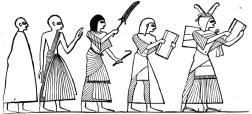

Ancient Egyptian Priests and Priestesses
Inside the temple’s most sacred shrine, the high priest was preparing a statue of Amun. Heavy incense perfumed the air as the priest reverently washed the statue and dressed it in a fine linen robe. Murmuring prayers, the priest adorned the statue with shining gold and precious stones. Amun would be pleased.
Hierarchy of the Priests
Temple Duties
The Ritual of Purification
Royal Priestesses
How Do We Know That?
Ancient Egyptian temples and shrines were very sacred
places. Only special people were
allowed into the temples: the priests, priestesses and pharaohs.
The Pharaoh was revered as the head of the priesthood.
Second only to the Pharaoh was the High Priest who carried out the
Pharaoh’s religious duties. Priests
were rich and powerful, and were ranked with the officers of the state. Priests
had many special privileges. They
were called by special names, wore special clothing and were allowed to
"see" the gods. In
ancient Egypt, most priests married and had families.
Hierarchy of the
Priests
The High Priest was usually a member of the royal family and was very close to
the Pharaoh. He had great power.
He controlled the wealth in the temple tr easuries and the lands of the
temple estate.
easuries and the lands of the
temple estate.
All priests had titles to indicate
their power and status. Some
priests received the title "God’s
Servant," followed by a ranking of first, second or third. Priests at lower levels
were called “Pure Ones.” They were responsible for maintaining the temple’s
property and keeping administrative records.
Top of Page
Temple Duties
Priests had many jobs to do in their temples.
They honored their god by singing, reading prayers and burning incense.
They kept an accurate count of the hours in each day and tracked the stars (especially important for agriculture and maintaining the
calendar.) Priests also healed the sick.
Egyptian priests made temple decisions, such as when rites were to begin in the morning. They also made national decisions, such as when to plant crops.
At each of the temples, the High
Priest had the specific job of caring for the god’s shrine.
As part of the ritual, he burned incense and sprinkled purified water on
the temple floors. Breaking the
shrine's clay seal, the priest would reveal the statue of the god, which he then
would bathe and dress in robes, necklaces and pendants.
An offering of food was also made to the god. When the High Priest left the sanctuary, another priest swept
the floor behind him so there was no trace of his presence.
Top of Page
The Ritual of Purification
Priests had to be clean for the gods and took
many steps to purify themselves. They
kept their heads and bodies shaved and would bathe in the temples’ sacred
lakes four times a day. Before and
after eating at temple rituals, priests washed with a mix of water and natron.
Top of Page
Royal Priestesses
Women were also permitted to play a role in
temple rituals. Most priestesses
served the goddess Hathor. Other
women priestesses worked in temples as dancers, musicians, singers and acrobats.
The most important priestess was known as the “God’s Wife of Amun.”
This woman was usually the daughter of the Pharaoh.
She held a very high position at court, and performed important rituals
to honor the god Amun.
Top of Page
How Do We Know That?
Egyptian
priests maintained public shrines to their gods.
A shrine painting (called a stela) from one of these shrines shows a man
praying to Amun. Six ears are
painted on the stela. These
“hearing ears” were believed to send prayers directly to the god.
Top of Page
Some images on this page are © 2000-2001 www.arttoday.com.